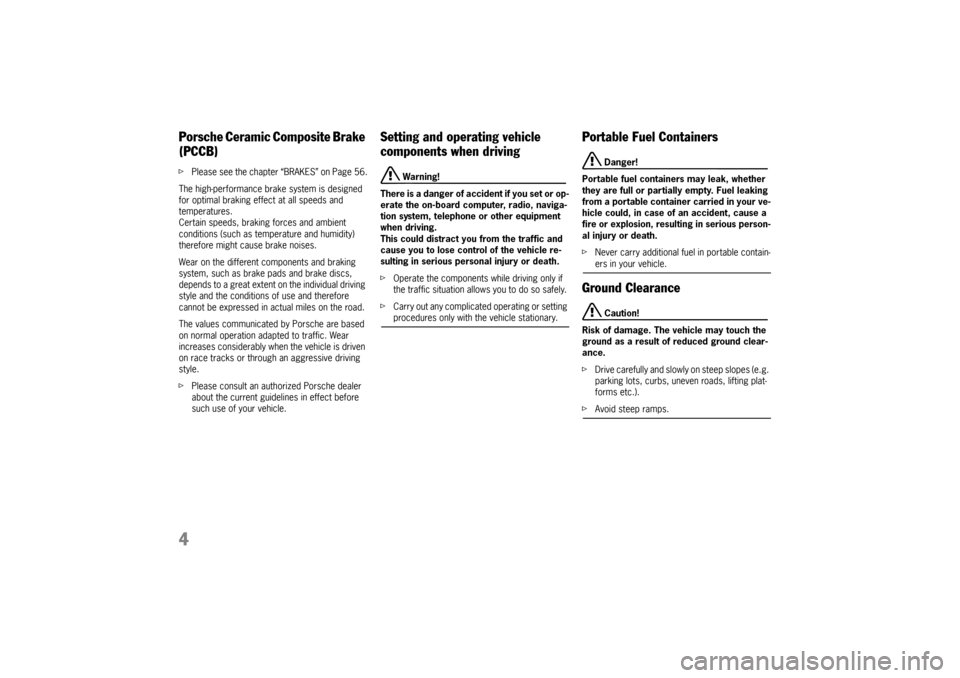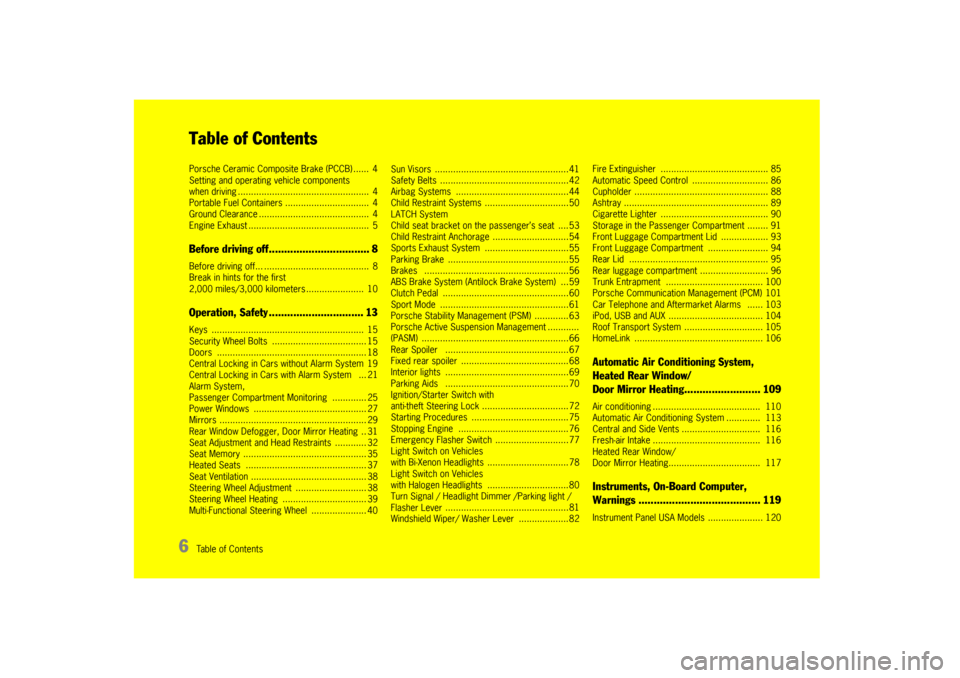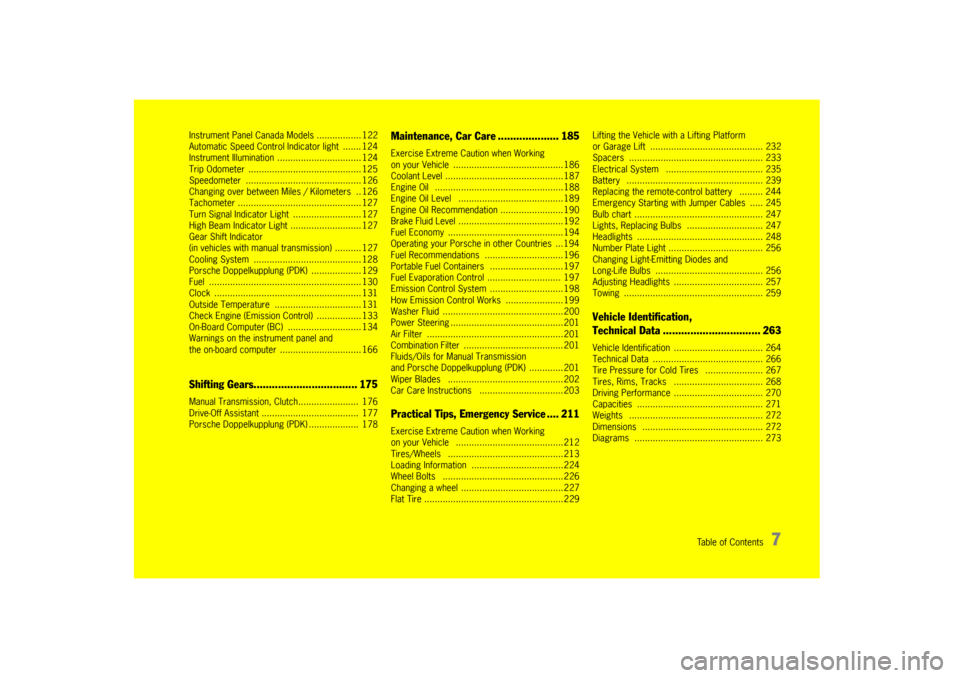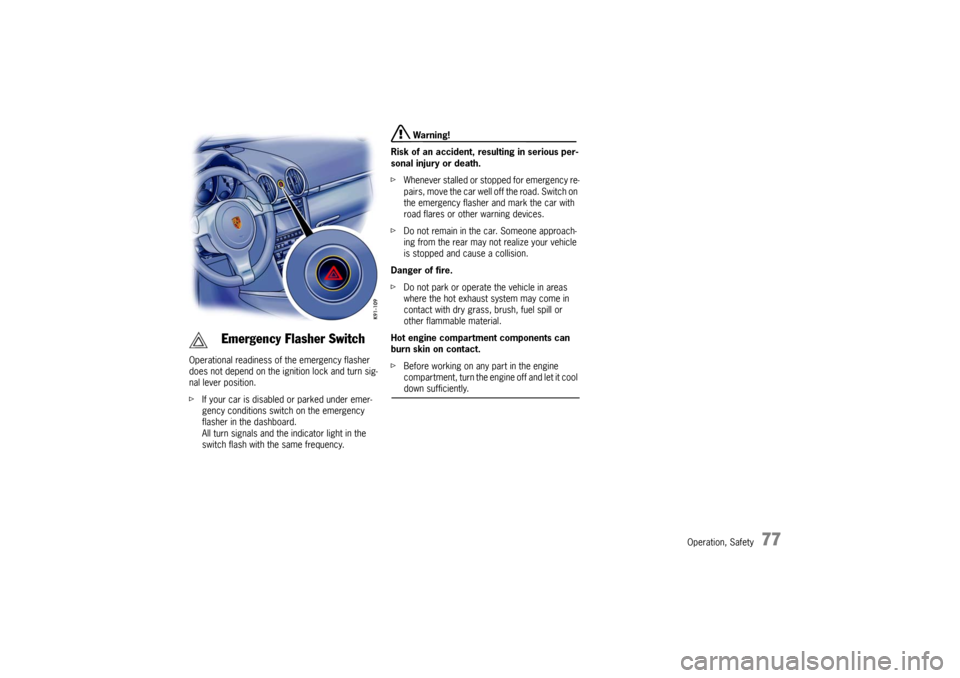fuel PORSCHE CAYMAN 2010 1.G Owners Manual
[x] Cancel search | Manufacturer: PORSCHE, Model Year: 2010, Model line: CAYMAN, Model: PORSCHE CAYMAN 2010 1.GPages: 284, PDF Size: 5.94 MB
Page 6 of 284

4Porsche Ceramic Composite Brake
(PCCB)fPlease see the chapter “BRAKES” on Page 56.
The high-performance brake system is designed
for optimal braking effect at all speeds and
temperatures.
Certain speeds, braking forces and ambient
conditions (such as temperature and humidity)
therefore might cause brake noises.
Wear on the different components and braking
system, such as brake pads and brake discs,
depends to a great extent on the individual driving
style and the conditions of use and therefore
cannot be expressed in actual miles on the road.
The values communicated by Porsche are based
on normal operation adapted to traffic. Wear
increases considerably when the vehicle is driven
on race tracks or through an aggressive driving
style.
f Please consult an authorized Porsche dealer
about the current guidelines in effect before
such use of your vehicle.
Setting and operating vehicle
components when driving
Warning!
There is a danger of acci dent if you set or op-
erate the on-board comp uter, radio, naviga-
tion system, telephone or other equipment
when driving.
This could distract you from the traffic and
cause you to lose control of the vehicle re-
sulting in serious personal injury or death.
f Operate the components while driving only if
the traffic situation allows you to do so safely.
f Carry out any complicated operating or setting procedures only with the vehicle stationary.
Portable Fuel Containers
Danger!
Portable fuel containers may leak, whether
they are full or partially empty. Fuel leaking
from a portable container carried in your ve-
hicle could, in case of an accident, cause a
fire or explosion, resulting in serious person-
al injury or death.
f Never carry additional fuel in portable contain-ers in your vehicle.
Ground Clearance
Caution!
Risk of damage. The vehicle may touch the
ground as a result of reduced ground clear-
ance.
f Drive carefully and slowly on steep slopes (e.g.
parking lots, curbs, uneven roads, lifting plat-
forms etc.).
fAvoid steep ramps.
Page 8 of 284

6
Table of ContentsTable of ContentsPorsche Ceramic Composite Brake (PCCB) ...... 4
Setting and operating vehicle components
when driving .................................................. 4
Portable Fuel Container s ................................ 4
Ground Clearance ....... ................................... 4
Engine Exhaust ........... ................................... 5Before driving off................................. 8Before driving off... . ....................................... 8
Break in hints for the first
2,000 miles/3,000 kilo meters ...................... 10Operation, Safety ............................... 13Keys ......................................... ................. 15
Security Wheel Bolts .................................... 15
Doors ........................... .............................. 18
Central Locking in Cars without Alarm System 19
Central Locking in Cars with Alarm System ... 21
Alarm System,
Passenger Compartment Monitoring ............. 25
Power Windows ............. .............................. 27
Mirrors ...................... .................................. 29
Rear Window Defogger, Door Mirror Heating .. 31
Seat Adjustment and Head Restraints ............ 32
Seat Memory ............. .................................. 35
Heated Seats ............ .................................. 37
Seat Ventilation ...... ...................................... 38
Steering Wheel Adjust ment ........................... 38
Steering Wheel Heatin g ................................ 39
Multi-Functional Steering Wheel ..................... 40 Sun Visors ...............
....................................41
Safety Belts ............. ....................................42
Airbag Systems ....... ....................................44
Child Restraint System s ................................50
LATCH System
Child seat bracket on the passenger’s seat ....53
Child Restraint Anchorage .............. ...............54
Sports Exhaust System ................................55
Parking Brake .......... ....................................55
Brakes ................... ....................................56
ABS Brake System (Antilock Brake System) ...59
Clutch Pedal ................ ................................60
Sport Mode ................. ................................61
Porsche Stability Manage ment (PSM) .............63
Porsche Active Suspensi on Management ............
(PASM) ........................ ................................66
Rear Spoiler ........... ....................................67
Fixed rear spoiler . ........................................68
Interior lights ................................ ...............69
Parking Aids ........... ....................................70
Ignition/Starter Switch with
anti-theft Steering Lo ck .................................72
Starting Procedures .....................................75
Stopping Engine .. ........................................76
Emergency Flasher Swit ch ............................77
Light Switch on Vehicles
with Bi-Xenon Headlig hts ...............................78
Light Switch on Vehicles
with Halogen Headlights ...............................80
Turn Signal / Headlight Dimmer /Parking light /
Flasher Lever
................................ ...............81
Windshield Wiper/ Washer Lever ...................82 Fire Extinguisher ....
..................................... 85
Automatic Speed Contro l ............................. 86
Cupholder ................... ................................ 88
Ashtray ....................... ................................ 89
Cigarette Lighter .... ..................................... 90
Storage in the Passenger Compartment ........ 91
Front Luggage Compart ment Lid .................. 93
Front Luggage Compar tment ....................... 94
Rear Lid ..................... ................................ 95
Rear luggage compartm ent .......................... 96
Trunk Entrapment .. ................................... 100
Porsche Communication Management (PCM) 101
Car Telephone and Aftermarket Alarms ...... 103
iPod, USB and AUX . ................................... 104
Roof Transport System .............................. 105
HomeLink ................... .............................. 106
Automatic Air Conditioning System,
Heated Rear Window/
Door Mirror Heating. ........................ 109Air conditioning ............ ............................. 110
Automatic Air Conditioning System ............. 113
Central and Side Vents .............................. 116
Fresh-air Intake ............ ............................. 116
Heated Rear Window/
Door Mirror Heating...... ............................. 117Instruments, On-Board Computer,
Warnings ........................................ 119Instrument Panel USA Models ..................... 120
Page 9 of 284

Table of Contents
7
Instrument Panel Canada Models ................. 122
Automatic Speed Control Indicator light ....... 124
Instrument Illumination ................................ 124
Trip Odometer ........... ................................ 125
Speedometer ................ ............................ 126
Changing over between Miles / Kilometers .. 126
Tachometer ............... ................................ 127
Turn Signal Indicator Light .......................... 127
High Beam Indicator Li ght ........................... 127
Gear Shift Indicator
(in vehicles with manual transmission) .......... 127
Cooling System ......... ................................ 128
Porsche Doppelkupplung (PDK) ................... 129
Fuel .......................... ................................ 130
Clock ............................ ............................ 131
Outside Temperature ................................. 131
Check Engine (Emission Control) ................. 133
On-Board Computer (B C) ............................ 134
Warnings on the instrument panel and
the on-board computer ............................... 166Shifting Gears........ .......................... 175Manual Transmission, Cl utch....................... 176
Drive-Off Assistant ...... ............................... 177
Porsche Doppelkupplung (PDK) ................... 178
Maintenance, Car Care .................... 185Exercise Extreme Caution when Working
on your Vehicle ........ ..................................186
Coolant Level ........... ..................................187
Engine Oil ............... ..................................188
Engine Oil Level .. ......................................189
Engine Oil Recommendat ion ........................190
Brake Fluid Level ...... ..................................192
Fuel Economy .......... ..................................194
Operating your Porsche in other Countries ...194
Fuel Recommendation s ..............................196
Portable Fuel Containers ............................197
Fuel Evaporation Control ............................ 197
Emission Control Syst em ............................198
How Emission Control Works ......................199
Washer Fluid ............ ..................................200
Power Steering ......... ..................................201
Air Filter .................. ..................................201
Combination Filter .... ..................................201
Fluids/Oils for Manual Transmission
and Porsche Doppelkuppl ung (PDK) .............201
Wiper Blades .......... ..................................202
Car Care Instructions ................................203Practical Tips, Emergency Service .... 211Exercise Extreme Caution when Working
on your Vehicle ............................ .............212
Tires/Wheels .......... ..................................213
Loading Information ...................... .............224
Wheel Bolts ................................. .............226
Changing a wheel .......................... .............227
Flat Tire ................... ..................................229 Lifting the Vehicle with a Lifting Platform
or Garage Lift ........
................................... 232
Spacers ..................... .............................. 233
Electrical System ..................................... 235
Battery ................. ................................... 239
Replacing the remote-con trol battery ......... 244
Emergency Starting with Jumper Cables ..... 245
Bulb chart .............. ................................... 247
Lights, Replacing Bulb s ............................. 247
Headlights ............. ................................... 248
Number Plate Light . ................................... 256
Changing Light-Emitting Diodes and
Long-Life Bulbs ........................... .............. 256
Adjusting Headlights .................................. 257
Towing ....................... .............................. 259
Vehicle Identification,
Technical Data ......... ....................... 263Vehicle Identification .................................. 264
Technical Data ....... ................................... 266
Tire Pressure for Cold Tires ...................... 267
Tires, Rims, Tracks .................................. 268
Driving Performance .................................. 270
Capacities ............. ................................... 271
Weights ..................... .............................. 272
Dimensions ........... ................................... 272
Diagrams ................... .............................. 273
Page 10 of 284

8
Before driving off...
Dear Porsche Owner A lot has gone into the manufacture of your
Porsche, including advanced engineering, rigid
quality control and demanding inspections.
These engineering and safety features will be
enhanced by you... the safe driver... – who knows his/her car and all controls,
– who maintains the vehicle properly,
– who uses driving skills wisely and always drives within her/his own capabilities and the
level of familiarity with the vehicle.
You will find helpful hints in this manual on how to
perform most of the checks listed on the following
pages.
If in doubt, have these checks performed by your
authorized Porsche dealer.
Before driving off... Check the following items first f Turn the engine off before you attempt any
checks or repairs on the vehicle.
f Be sure the tires are inflated correctly.
Check tires for damage and tire wear.
f See that wheel bolts are properly tightened
and not loose or missing.
f Check engine oil level, add if necessary.
Make it a habit to have engine oil checked with
every fuel filling.
f Check all fluid levels such as windshield
washer and brake fluid levels.
f Be sure the vehicle battery is well charged and
cranks the engine properly.
f Check all doors and lids for proper operation
and latch them properly.
f Check, and if necessary replace worn or
cracked wiper blades.
f See that all windows are clear and unob-
structed.
f Check air intake slots and area between lug-
gage compartment lid and windshield. Ensure
that these areas are free of snow and ice, so
the heater and the windshield wipers work
properly. f
If a child will be riding in the vehicle, check
child seat/child seat restraint system to ensure
that restraints are properly adjusted.
f Child restraint systems will not fit into the
Sports bucket seat.
Do not install a child restraint system in the
Sports bucket seat.
The Sports bucket seat cannot be equipped
with the LATCH system and thus the airbag
system cannot be manually deactivated.
f Check all exterior and interior lights for opera-
tion and that the lenses are clean.
f Check the headlights for proper aim, and if
necessary, have them adjusted.
f Check under the vehicle for leaks.
f Be sure all luggage is stowed securely.
Emergency equipment It is good practice to carry emergency equipment
in your vehicle.
Some of the items you should have are:
window scraper, snow brush, container or bag of
sand or salt, emergency light, small shovel, first-
aid kit, etc.
Page 11 of 284

Before driving off...
9
In the driver’s seat... fCheck operation of the horn.
f Position seat for easy reach of foot pedals and
controls.
To reduce the possibility of injury from the
airbag deployment, you should always sit back
as far from the steering wheel as is practical,
while still maintaining full vehicle control.
f Adjust the inside and outside rear view mirrors.
f Buckle your safety belts.
f Check operation of the foot and parking brake.
f Check all warning and indicator lights with
ignition on and engine not running.
f Start engine and check all warning displays for
warning symbols.
f Never leave an idling car unattended.
f Lock doors from inside, especially with chil-
dren in the car to prevent inadvertent opening
of doors from inside or outside.
Drive with doors locked.
On the road... fNever drive after you have consumed alcohol
or drugs.
f Always have your safety belt fastened.
f Always drive defensively.
Expect the unexpected.
f Use signals to indicate turns and lane changes.
f Turn on headlights at dusk or when the driving
conditions warrant it.
f Always keep a safe distance from the vehicle in
front of you, depending on traffic, road and
weather conditions.
f Reduce speed at night and during inclement
weather.
Driving in wet weather requires caution and re-
duced speeds, particularly on roads with
standing water, as the handling characteristics
of the vehicle may be impaired due to hydro-
planing of the tires.
f Always observe speed limits and obey road
signs and traffic laws.
f When tired, get well off the road, stop and take
a rest. Turn the engine off. Do not sit in the ve-
hicle with engine idling.
Please see the chapter “ENGINE EXHAUST” on
Page 5. f
When parked, always set the parking brake.
Move the PDK selector le ver to ”P“ or the gear-
shift lever to reverse or first gear.
On hills also turn the front wheels toward the
curb.
f When emergency repairs become necessary,
move the vehicle well off the road. Turn on the
emergency flasher and use other warning de-
vices to alert other motorists. Do not park or
operate the vehicle in areas where the hot ex-
haust system may come in contact with dry
grass, brush, fuel spill or other flammable ma-
terial.
f Make it a habit to have the engine oil checked
with every refueling.
Page 12 of 284

10
Before driving off...
Break in hints for the first
2,000 miles/3,000 kilometers The following tips will be helpful in obtaining opti-
mum performance from your new Porsche.
Despite the most modern, high-precision manufac-
turing methods, the moving parts must still wear
in with each other. This we aring-in occurs mainly in
the first 2,000 miles/3,000 kilometers.Therefore: f Preferably take longer trips.
f Avoid frequent cold starts with short-distance
driving whenever possible.
f Avoid full throttle starts and abrupt stops.
f Do not exceed maximum engine speed of
4,200 rpm (revolutions per minute).
f Do not run a cold engine at high rpm either in
Neutral or in gear.
f Do not let the engine labor, especially when
driving uphill. Shift to the next lower gear in
time (use the most favorable rpm range).
f Never lug the engine in high gear at low
speeds. This rule applies at all times, not just
during the break-in period. f
Do not participate in motor racing events,
sports driving schools, etc. during the first
2,000 miles/3,000 kilometers.
There may be a slight stiffness in the steering,
gear-shifting or other controls during the break-in
period which will gradually disappear.
Break in brake pads and brake discsNew brake pads and discs ha ve to be “broken in”,
and therefore only attain optimal friction when the
car has covered several hundred miles or km.
The slightly reduced braking ability must be com-
pensated for by pressing the brake pedal harder.
This also applies whenev er the brake pads and
brake discs are replaced. New tires New tires do not have maximum traction. They
tend to be slippery.
f Break in new tires by driving at moderate
speeds during the first 60 to 120 miles/100 to
200 km. Longer braking distances must be an-
ticipated.
Engine oil and fuel consumption During the break-in peri od oil and fuel consump-
tion may be higher than normal.
As always, the rate of oil consumption depends on
the quality and viscosity of oil, the speed at which
the engine is operated, the climate and road con-
ditions, as well as the amount of dilution and oxi-
dation of the lubricant.
f Make a habit of checking engine oil with every
refueling, add if necessary.
Page 63 of 284

Operation, Safety
61
Sport ModeA sportier car set-up is obtained when Sport mode
is switched on. Interventions by the Porsche
control systems are intentionally shifted towards
greater agility and driving performance:
– PASM (Porsche Active Suspension Manage-ment) is automatically changed to Sport mode,
resulting in a stiffer suspension setup.
– When Sport mode is active, the PDK transmis- sion switches to a sporty gear-changing map
and shortens the gear shifting times. Gear
changes take place faster, but fuel consump-
tion is also increased.
PSM (Porsche Stability Management) control
gives a sportier road-feel to the vehicle. PSM
interventions take place later than in Normal
mode. The driver can maneuver the vehicle
with greater agility at its performance limits,
without having to dispense with the assistance
of PSM in emergency situations. This helps to
achieve optimal lap times, particularly on race
circuits with a dry road surface.
– The electronic accelerator pedal reacts sooner, and the engine is more responsive to
throttle inputs. When Sport mode is switched
on, this function is ac tivated only after the
driver has floored the accelerator pedal or
released it briefly.
– The rpm limiter characteristic is “harder”, i.e. the engine is immediately throttled when the
performance limits are reached (only in manual selection mode for vehicles with PDK transmis-
sion).
f Please observe the chap ters on PSM, PASM
and PDK.
Switching Sport mode on and offSwitching Sport mode on and off simultaneously
activates and deactivate s the Sport mode in
PA S M .
If PASM Sport mode was activated with the PASM
button, PASM remains active.
After the ignition is switched off, Sport mode is
automatically reset to Normal mode.
SPORT button
f Press SPORT button A in the center console.
When Sport mode is switched on, the light-
emitting diode in the SPORT button is lit.
A sporty gear-changing map is enabled and the
gear shifting times ar e shortened for the PDK
transmission.
A sporty driving style is recognized more quickly
and the gear-changing speeds are adapted to
driving performance.
Deceleration downshifts are commenced earlier.
Downshifts are made during slight decelerations,
even at higher engine speeds.
f Please see the chapter “SPORT MODE
(“SPORT” AND “SPORT PLUS” MODES)” on
Page 180. SPORT PLUS button
(only on vehicles with PDK transmission)
In “Sport Plus” mode, the PDK transmission
changes to a shift program designed for driving
on race circuits. 7th gear is not selected.
The gear-changing performance is enhanced
significantly again compared with “Sport” mode.
f
Please see the chapter “SPORT MODE
(“SPORT” AND “SPORT PLUS” MODES)” on
Page 180.
f Press SPORT PLUS button B in the center
console.
When Sport mode is switched on, the light-
emitting diode in the SP ORT PLUS button is lit.
Page 77 of 284

Operation, Safety
75
Starting Procedures fPlease see the chapter “IMMOBILIZER” on
Page 15.
f Please see the chapter “EMISSION CONTROL
SYSTEM” on Page 198.
Warning!
Serious injury or death may result if you are
involved in a collision without having fas-
tened the safety belts.
f Fasten safety belts before driving away. Before starting the engine fApply the footbrake.
f Manual transmission:
Fully depress the clutch pedal and put the gear-
shift lever into neutral.
The clutch pedal must be depressed fully
before the starter will engage.
f In vehicles with PDK transmission:
Move PDK selector lever to position P or N.
Temperature sensors on the engine automatically
provide the correct fuel/air mixture required for
starting.
Therefore, it is not necessary to depress the
accelerator pedal while starting a cold or a
warm engine.
Starting the enginef Turn ignition key to ignition lock position 2.
f As soon as the engine st arts, release the igni-
tion key.
The first operation of the starter is ended automat-
ically when the engine starts.
If the engine does not start, subsequent starter
operations will not be ended automatically.
If the engine fails to start after 10 or 15 seconds
of cranking:
f Wait about 10 seconds before engaging the
starter again.
f When starting the engine, be ready to drive
immediately.
Drive vehicle at moderate speeds and avoid
engine speeds above 4,200 rpm during the
first 5 minutes.
f Do not let the engine idle to warm up.
Danger!
Engine exhaust fumes have many compo-
nents which you can smell. They also contain
carbon monoxide (CO), which is a colorless
and odorless gas.
Carbon monoxide can cause unconscious-
ness and even death if inhaled.
f Never start or let the engine run in an
enclosed, unventilated area.
It is not recommended to sit in your car for prolonged periods with the engine on and the
car not moving.
An unattended vehicle with a running engine
is potentially hazardous.
If warning lights shoul d come on to indicate
improper operation, they would go unno-
ticed.
f Never leave the engine idling unattended.
Danger of fire.
f Do not park or operate the vehicle in areas
where the hot exhaust system may come in
contact with dry grass, brush, fuel spill or oth-
er flammable material.
f If your car catches on fire for any reason, call
the fire department.
Do not endanger your life by attempting to put
out the fire.
Risk of burn injury when standing near or
coming into contact with the exhaust pipe.
The exhaust pipe is hot when the vehicle is running
and remains hot for some time after the vehicle is
turned off.
f To prevent injury, make a point of noting where
your vehicle’s exhaust pipe is, avoid placing
your legs near the exhaust pipe, and closely
supervise children around the vehicle when the
exhaust pipe could be hot.
A hot exhaust pipe can cause serious burns.
Page 79 of 284

Operation, Safety
77
Operational readiness of the emergency flasher
does not depend on the ignition lock and turn sig-
nal lever position.
f If your car is disabled or parked under emer-
gency conditions switch on the emergency
flasher in the dashboard.
All turn signals and the indicator light in the
switch flash with the same frequency.
Warning!
Risk of an accident, re sulting in serious per-
sonal injury or death.
f Whenever stalled or stopped for emergency re-
pairs, move the car well off the road. Switch on
the emergency flasher and mark the car with
road flares or other warning devices.
f Do not remain in the car. Someone approach-
ing from the rear may not realize your vehicle
is stopped and cause a collision.
Danger of fire.
f Do not park or operate the vehicle in areas
where the hot exhaust system may come in
contact with dry grass, brush, fuel spill or
other flammable material.
Hot engine compartment components can
burn skin on contact.
f Before working on any part in the engine
compartment, turn the engine off and let it cool down sufficiently.
Emergency Flasher Switch
Page 107 of 284

Operation, Safety
105
Roof Transport SystemfPlease follow the separate instructions for fit-
ting the Roof Transport System.
f Only use Roof Transport Systems from the
Porsche Tequipment product range or Roof
Transport Systems which have been tested
and approved for your car by Porsche. Fitting
normal commercially available luggage racks
is not possible.
The Porsche Roof Transport System allows you
to carry various sports and hobby equipment.
Your Porsche partner will be pleased to tell you
about the various different uses of the Roof Trans-
port System.
Caution!
f Risk of damage to the paint on the rear lid.
Only open the rear lid if this cannot touch the
load.
f Completely remove the Roof Transport System
b e f o re u s i n g a n a u t o m a t i c c a r w a s h - r i s k o f d a -
mage to the vehicle!
f Do not exceed the maximum permitted pay-
load of 132 lbs. (60 kg), the maximum permit-
ted gross weight and the maximum permitted
axle loads.
f Please see the chapter “WEIGHTS” on
Page 272. f
Distribute load evenly, storing heavy items as
low as possible. Items of luggage must not
project beyond the side of the load area.
f Fix and secure every item to the basic carrier
with a rope or lashing strap (do not use elastic
rubber tensioners).
f Before every trip, and at regular intervals
during long trips, check that Roof Transport
System and load are secu re. Re-tighten if ne-
cessary and secure additionally by locking.
f When the Roof Transport System is loaded, the
maximum speed depends on the nature, size
and weight of the load being carried. But never
drive faster than 90 mph (140 km/h).
f With the basic carrier fitted and no load, do not
exceed a maximum speed of 110 mph
(180 km/h).
f Driving, braking and steering behavior change
due to the higher center of gravity and the gre-
ater wind-resistant area. You should adapt your
driving style appropriately.
f Since fuel consumption and noise are incre-
ased with the Roof Transport System fitted, it
should not remain on the vehicle if not in use.